#Galleria Residences
Explore tagged Tumblr posts
Text
Gắn WiFi Viettel Chung cư The Galleria Residence - Ưu đãi LỚN
Khuyến mãi Gắn WiFi Viettel Chung cư The Galleria Residence, địa chỉ 20 Nguyễn Thiện Thành, Thành Phố Thủ Đức, Hồ Chí Minh, là giải pháp hoàn hảo cho những cư dân mong muốn một kết nối internet ổn định và mạnh mẽ. Với nhu cầu khách hàng Viettel ngày càng cao, Viettel mang đến các gói cước linh hoạt, phù hợp cho cả cá nhân và hộ gia đình. Viettel sử dụng công nghệ cáp quang GPON tiên tiến, kết hợp…
0 notes
Text
Galleria Residency
7003, Sector 30 M Wide Main Rd, Near, Supermart 2, Block C2, Dlf Garden Villas, Sector 43, Gurugram, Haryana 122009, Sector 30, Gurugram

0 notes
Text
SR Azul Ashengrotto - Luxe Couture Vignette
"Please come this way"
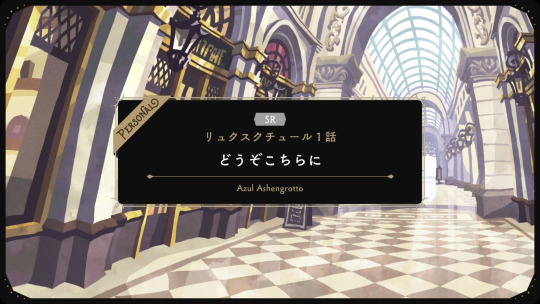
[Fairest City – Crystal Galleria]
Azul: …Now, now, don't say that!
Azul: I would be honored if you would come by the Mostro Lounge to come see my photo with Eric-san.
Vil: I'm staggered. You would not only use my father, but also myself to increase your reputation?
Grim: Oh hey, if it ain't Vil and Azul. What're you guys talkin' about?
Azul: We just happened to come across each other over here, so we were merely chatting about plans once we return to campus. Have the two of you been shopping?
1. I bought some clothes for myself.
Azul: You bought clothing at the Crystal Galleria? You must be a better shopper than I thought.
2. I bought some gifts for everyone back home.
Azul: A wonderful sentiment. Keeping people in your debt is very valuable.
Azul: I myself just finished purchasing some cosmetics. After this, I plan on perusing some tableware.
Grim: Huh, tableware? Don't really matter what gets used, to me.
Grim: The food 'n drinks're waaay more important than the plates 'n cups.
Azul: I fully believed that would be your response, Grim-san.
Vil: I absolutely adore that sort of dedication. The more opulent the tableware, the more sophisticated the mealtime becomes.
Vil: Weren't the plates, cups, and cutlery at the restaurant we dined at yesterday utterly sublime?
Grim: I don't remember a thing about 'em.
Vil: ...Right, I was a fool for even asking that in the first place.
Azul: The golden rimmed white porcelain plates at that restaurant was indeed spectacular.
Azul: Decorated in both matte and glossy gold, these surely were high-quality wares. A rare sight, indeed.
Vil: Well, now. You're well informed, Azul.
Vil: It may be interesting to shop for tableware with someone who actually knows a thing or two. I'll join you.
Azul: Why, certainly. Would you like to join us, [Yuu]-san?
1. I'd like to. 2. I'm definitely interested.
Grim: 'Kay, then I'll tag along too, then. But anyway, do they even sell stuff like that here?
Vil: Of course. Fine ceramic wares are yet another major product of the Fairest City. There are also many antique shops.
Grim: Uh-huh. So it's not just make-up 'n clothes 'n food, huh.
Azul: It is said that there were 3 primary factors that led to the development of those fine ceramic wares in the Fairest City.
Azul: The first factor was due to the nearby mines.
Azul: The neighboring mountain range had an abundance of high-quality clay, for which artisans from all over began to come for.
Azul: The second factor is the development of pharmaceuticals thanks to knowledge passed down from the Fairest Queen.
Vil: That pharmaceutical science was then used to develop a diverse array of pigments, and that allowed for the field of colors to become what it is today.
Azul: Indeed. It's just as you say.
Azul: And the final factor is the sense of beauty that every Fairest Queen-loving inhabitant of the Fairest City carries.
Azul: Thus, the potters and sculptors who were raised with a heightened awareness of beauty themselves brought their ceramics to an entirely new level when it comes to works of art.
Vil: Only the residents of the Fairest City would find ways to elevate beauty in fields other than fashion and makeup.

Azul: We've arrived. I hear this shop carries a rather large collection of antique tableware for sale.
Vil: Have you already done prior research?
Azul: Yes, indeed. I must admit I have been looking forward to purchasing new tableware.

Grim: Woah! There's a ton of sparkly dishes and stuff!
Vil: What sort of tableware are you planning on purchasing, Azul?
Azul: I believe I'd like to find teacups, saucers, and a matching teapot.
1. What about this golden tea set?
Grim: Yeah! The shiny gold color is so cool! Azul: I see they allowed gold to oxidize and used that to create a pattern for the design. I must admit it is extravagant and definitely draws an eye. Vil: An opulent design. However, I feel it may not suit the Mostro Lounge.
2. Look at this pink tea set!
Azul: I see it is a set of teacups with a frill molding. The flower pattern along the rim is so wonderfully subtle. Vil: A rather cute design. However, I feel it may not suit the Mostro Lounge.
Azul: Fufu, I agree completely. Perhaps now we can look at the wares that had caught my eye?
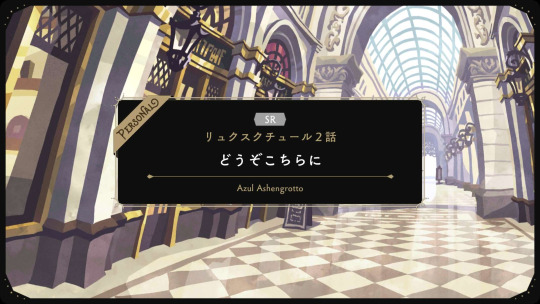
[Fairest City – Crystal Galleria]
Azul: This is the one I am looking to purchase here.
Grim: This one, huh? It's just a borin' looking white cup with a tiny bit of blue stuff on it.
Azul: That dainty and subtle touch is intended to be its charm point… It seems you fail to comprehend that, Grim-san.
Azul: This bright white porcelain shows not a hint of translucency… Does it not seem to be the pinnacle of class?
Vil: It certainly does have a refined beauty about it.
Azul: The elegant design carved out of the rim of the teacup is called a "scalloped rim."
Azul: And consider this wave-like handle curled along the side… Even the minute details are so stunning.
Grim: A handle? What, you gonna steer somethin' with this cup, then?
Vil: Obviously the handle is where you hold the cup.
Vil: But, Azul. These cups and teapot are a vintage set.
Vil: Is there any need for you to use such an extravagant tea set in a café that caters to students?
Azul: Indeed. I consider this a necessary investment.
Azul: Just because my customers are students does not mean that I intend on compromising my standards.

[Fairest City – Queen's Palace]
[camera shutters clicking and screaming]
Fans: KYAAAAAAAAA! VIL-SAMAAAAA!!!
Reporter: If I can run an article on Vil Schoenheit, then there's no doubt that both magazine sales and website traffic are gonna go through the roof!
Reporter: Alright, now I just gotta hop this barrier so I can cover Vil Schoenheit up close…
[Grrk…]
Azul: Oh, my, it is dangerous to attempt to climb the barrier. Please take all photographs from the designated area.
Reporter: You little brat, don't get in my way! [Azul starts pushing] Urgh, what strength! He's pushing the whole barrier back towards me…!
Azul: If those instructions cannot be followed properly, I may have to take appropriate countermeasures…
Azul: For example, I may be inclined to ring up your place of employment and file a complaint at the highest levels.
Reporter: Okay, fine, just get out of my way, then! I can't even take a picture with you like this!

Azul: How wonderful that we've reached an understanding. Vil-san, please come this way.
Vil: Thank you… You were awfully efficient in handling that.
Azul: When you've made as many deals as I have, it's not uncommon to encounter troubled clients in need of extra firm handling.
Azul: I'm just glad I was able to put the mediation skills I've accumulated to good use.
Vil: Not only are you handling the press well… But you are doing a fantastic job as my escort.
Azul: Well, it also is not uncommon for me to host prospective business contacts personally, either.
Azul: Ah, we are almost at the staircase.
Azul: Right this way. If you wish, my hand is yours to take.
Vil: Well, then. I shall accept it.

―A few days later
[Mostro Lounge]
Octavinelle Student: Welcome!
Azul: Oh my… If it isn't Vil-san! You've come, as promised! I'm so elated.
Vil: Excuse you. I don't recall ever promising you anything. However…
Vil: I was merely thinking back to how you handled yourself previously. I do expect exceptional service today as well.
Vil: Business seems to be going well… Are you using that tea set you purchased back then?
Azul: I am. Right now… The guests at that table are enjoying the tea served in it.

Deuce/Epel: AHAHAHA!
Vil: …There is no way those two even remotely understand the worth of those cups.

Vil: Neither would the rest of these customers. Do you still think that it was worth selecting that specific set?
Azul: Absolutely. I vow to serve drinks and meals on quality dishes that I have personally selected.
Azul: That is something that I will never compromise as the proprietor of the Mostro Lounge.
Azul: You yourself would never touch clothes or cosmetics that don't suit your design or aesthetic taste, yes?
Vil: So, just as I carefully concoct my personal brand by being particular on how I fashion myself…
Vil: You look to enhance the Mostro Lounge by careful consideration of the tableware and table linen.
Vil: I think that fastidious approach of yours is just as spectacular. Perhaps I have judged you a tad harshly.
Azul: Why, thank you. I fully believed that you of all people would understand, Vil-san.
Azul: However… I cannot deny that at times I would like to share that appreciation of the tableware's elegance with someone who actually understands their worth.
Azul: That being said, Vil-san, allow me to prepare your order on my absolute finest plates.

Requested by Anonymous.
#twisted wonderland#twst#azul ashengrotto#vil schoenheit#deuce spade#epel felmier#twst azul#twst vil#twst deuce#twst epel#twst grim#twst yuu#twst translation#twst tapis rouge#mention: eric
262 notes
·
View notes
Text

Rome's Vestal Virgins: Protectors of The City's Sacred Flame
Chosen as young girls, the priestesses of Vesta, goddess of the hearth, swore a 30-year vow of chastity and in turn were granted rights, privileges, and power unavailable to other women in Rome.
Marcus Licinius Crassus was one of the richest and most powerful Roman citizens in the first century B.C. Yet he nearly lost it all, his life included, when he was accused of being too intimate with Licinia, a Vestal Virgin. He was brought to trial, where his true motives emerged. As the first-century historian Plutarch recounts, Licinia was the owner of “a pleasant villa in the suburbs which Crassus wished to get at a low price, and it was for this reason that he was forever hovering about the woman and paying his court to her.” When it became clear that Crassus’ wooing was motivated by avarice rather than lust, he was acquitted, saving both his and Licinia’s lives.
One of the most remarkable elements of this story is the fact that Licinia owned a villa in the first place. Unlike other women, Licinia could own property precisely because she was a Vestal Virgin. The story of her trial also reveals how that privilege came with a price: A Vestal Virgin had to abstain from sex, a sacred obligation to one of Rome’s most ancient customs that would continue until Christianity ended the cult in A.D. 394.

FIRE GODDESS: The remains of the Temple of Vesta stand in the Roman Forum. Unlike most temples, it did not contain a central image of the goddess. It was the site of the holy fire and a repository of various sacred artifacts.
Vestal Veneration
According to Roman authors, the cult was founded by Numa Pompilius, a semi-mythical Roman king who ruled around 715 to 673 B.C. Unlike most Roman religious cults, worship of Vesta was run by women. The hearth was sacred to this goddess, one of Rome’s three major virgin goddesses (the other two being Minerva and Diana). The rites surrounding the Vestals remained relatively fixed from the time of the Roman Republic through the fourth century A.D.
Six virgin priestesses were dedicated to Vesta as full-time officiates who lived in their own residence, the Atrium Vestae in the Roman Forum. The Vestals’ long tradition gave Romans a reassuring thread of continuity and may explain the Temple of Vesta’s traditional circular form, a style associated with rustic huts in the city’s deep past.

KEEP THE FIRE The Vestal Virgins tend the sacred fire of Vesta, on whose protection Rome depends. 17th-century oil painting by Ciro Ferri, Galleria Spada, Rome
This place of worship, which lay alongside the Atrium, was where the priestesses tended the goddess’s sacred fire. Once a year, in March, they relit the fire and then ensured it remained burning for the next year. Their task was serious as the fire was tied to the fortunes of their city, and neglect would bring disaster to Rome.
To become a Vestal was the luck of the draw. Captio, the process whereby the girls were selected to leave their families and become priestesses, is also the Latin word for “capture”—a telling turn of phrase that evokes the kidnapping of women for brides that took place in archaic Rome. Records from 65 B.C. show that a list of potential Vestals was drawn up by the Pontifex Maximus, Rome’s supreme religious authority. Candidates had to be girls between the ages of six and 10, born to patrician parents, and free from mental and physical defects. Final candidates were then publicly selected by lot. Once initiated, they were sworn to Vesta’s service for 30 years.
On being selected, their life was spent at the Atrium Vestae in a surrogate family, presided over by older Vestals. In addition to room and board, they were entitled to their own bodyguard of lictors. For the first 10 years they were initiates, taught by the older priestesses. Then they became priestesses for a decade before taking on the mentoring duties of the initiates for the last 10 years of their service.
Training the Novices
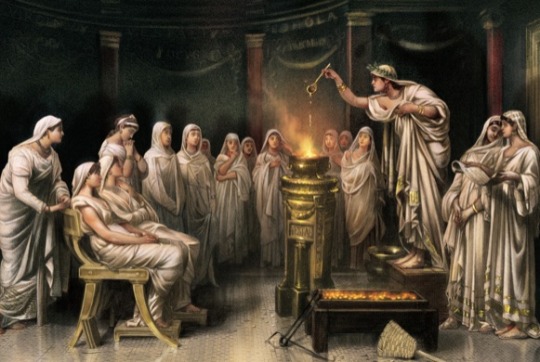
"The School of the Vestal Virgins" 19th-century colorized engraving by L. Hector Leroux.
After lots were drawn from the list of young girls who could serve Vesta, initiates were brought to the Atrium Vestae, where their training would begin. The training was overseen by the chief priestess, the Vestalis Maxima, who came under the authority of the Pontifex Maximus. The first 10 years were spent training for their duties. They would spend the second decade actively administering rites, and the final 10 were spent training novices. The chastity of the priestesses was a reflection of the health of Rome itself. Although spilling a virgin’s blood to kill her was a sin, this did not preclude the infliction of harsh corporal punishment. First-century historian Plutarch writes: “If these Vestals commit any minor fault, they are punishable by the high-priest only, who scourges the offender.”
Public monies and donations to the order funded the cult and the priestesses. In Rome religion and government were tightly intertwined. The organization of the state closely mirrored that of the basic Roman institution: the family. The center of life of the Roman home, or domus, was the hearth, tended by the matriarch for the good of her family and husband. In the same way, the Vestals tended Vesta’s flame for the good of the state.
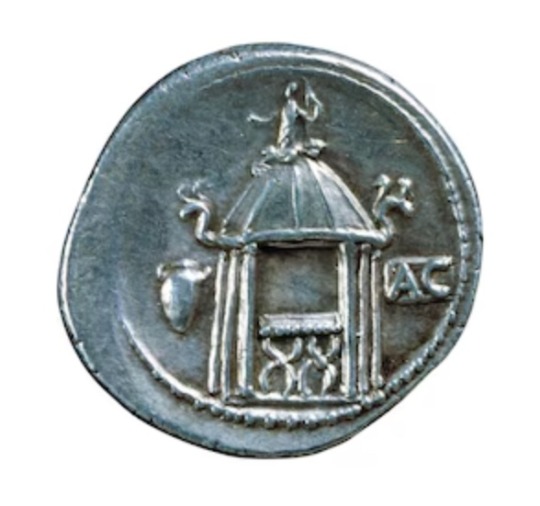
A silver denarius, also from the second century B.C., bears a representation of the circular Temple of Vesta.
Unlike other Roman women, Vestals enjoyed certain privileges: In addition to being able to own property and enjoying certain tax exemptions, Vestals were emancipated from their family’s patria potestas, patriarchal power. They could make their own wills and give evidence in a court of law without being obliged to swear an oath.
Thirty Years of Chastity
These rights came at a high price: 30 years of enforced chastity. Many historians believe that the health of the state was tied to the virtue of its women; because the Vestals’ purity was both highly visible and holy, penalties for a Vestal breaking her vow of chastity were draconian. As it was forbidden to shed a Vestal Virgin’s blood, the method of execution was immuration: being bricked up in a chamber and left to starve to death. Punishment for her sexual partner was just as brutal: death by whipping. Throughout Roman history, instances are cited of these grim sentences being passed.
Jealousy or malice made the women vulnerable to false accusations. One story, celebrated by several Roman writers, concerns the miracle of the Vestal Virgin Tuccia, who was falsely accused of being unchaste. According to tradition, Tuccia beseeched Vesta for help and miraculously proved her innocence by carrying a sieve full of water from the Tiber.
Allegations of crimes against the Vestals’ chastity sometimes went to the top of the social order. The flamboyantly eccentric, third-century emperor Elagabalus actually married a serving Vestal Virgin. It is a sign of the enduring symbolic importance of the cult that this heresy was one major factor that led to his deposal and murder.

The Vestal Tuccia, falsey accused of breaking her chastity vow, is saved by the intervention of Vesta, who enables her to carry water in a sieve from the Tiber back to the temple. 17th-century painting by Giovanni Battista Beinaschi.
Vestal Vestments
The ceremonial dress of Vestals highlights their dual, and somewhat contradictory, embodiment of both the maternal and the chaste. Physical appearance was an integral part of their role, making them stand out as different from other women, but also echoing physical traits of conventional women.
Dressed in white, the color of purity, the Vestal Virgins wore stola, long gowns worn by Roman matrons. Hair and headdresses played an important symbolic function. The Vestal hairstyle is described in Roman sources using an ancient Latin phrase, the seni crines. Historians cautiously agree it means “sixbraids,” and is mentioned as the coiffure of both Vestal Virgins and brides. A Vestal wore the suffibulum, a short, white cloth similar to a bride’s veil, kept in place with a brooch, the fibula. Around their heads they wore a headband, the infula, which was associated with Roman matrons.
Daily rites for Vestals were often centered around the temple. Most important was maintaining the holy fire. If the fire went out, the attending Vestals would be suspected not only of neglect but also of licentiousness, since it was believed impurity in a Vestal’s relations would cause a fire to go out. Other typical duties included the purification of the temple with water, which had to be drawn from a running stream. In readiness for the numerous festivals that required their attendance, the priestesses were required to bake salsa mola, a cake of meal and salt that was sprinkled on the horns of sacrificed animals. Important religious festivals included the Vestalia, dedicated to their goddess, Vesta, and the Lupercalia, which highlights the contradictory role of the Vestal Virgins, as it was closely associated with fertility.

A representation of a Vestal Virgin.
A Roman Tradition

A bust of Numa Pompilius from the Villa Albani Museum in Rome, believed to have been sculpted in the Roman Imperial Period.
Romans believed the cult of the Vestal Virgins was instituted under the eighth-century B.C. king Numa Pompilius, the successor of Rome’s founder, Romulus. First-century A.D. historian Plutarch wrote that Numa may have “considered the nature of fire to be pure and uncorrupted and so entrusted it to uncontaminated and undefiled bodies.“ Numa is credited by Livy, in his History of Rome, with formalizing other key Roman cults, including those of Jupiter and Mars. Many historians believe Numa was legendary, and that the worship of Vesta and other cults developed slowly out of pre-Roman customs, perhaps dating back to the older Etruscan culture that dominated Italy before the rise of Rome.
In the innermost part of their temple, the priestesses looked after their secret talismans. Among these objects was the sacred phallus, the fascinus, the representation of a minor god of the same name. The fascinus (the root of the word “fascinate”) is closely bound with magic and fertility. It was also in this part of the temple that they probably kept the palladium, the statue of Pallas Athena that the legendary founder of Rome, Aeneas, brought to Italy after the destruction of Troy, his home city—another aspect of the Vestal cult that tied Rome’s origins into an ennobling and ancient tradition.
Romans regarded these priestesses with a sense of awe. Plutarch points out “they were also keepers of other divine secrets, concealed from all but themselves.” It was believed they possessed magical powers: If anybody condemned to death saw a Vestal on his way to being executed, he was to be freed, so long as it could be proven the meeting was not by design. Vestals, it was said, could stop a runaway slave in his tracks.
The privileged position of the Vestal Virgins in Roman society survived for more than a thousand years, passing through Rome’s changing systems of monarchy, republic, and empire. The cult would not, however, survive Christianity. In A.D. 394 Theodosius closed the House of the Vestals forever, freeing the virgins from their obligations, but also removing their privileges.

VIEW OF THE VESTAThe ruins of the Atrium Vestae stand in the Roman Forum. The rectangular pools formed a part of the complex’s long, central patio. To the right of the Atrium are the remains of the Temple of Vesta, and behind the wall are the three remaining columns of the Temple of Castor and Pollux.
Even as their flame was extinguished, aspects of the cult may have passed into the new faith as it swept through the Mediterranean. Just as the position of the Pontifex Maximus lived on in the papal title “pontiff,” young women in the early years of Roman Christianity embraced virginity and celibacy in their desire to be “eunuchs for the love of heaven.” Scholars believe the role of the Christian nun was inspired, in part, by the chaste figures who dutifully tended the holy flame of Vesta.
By Elda Biggi.



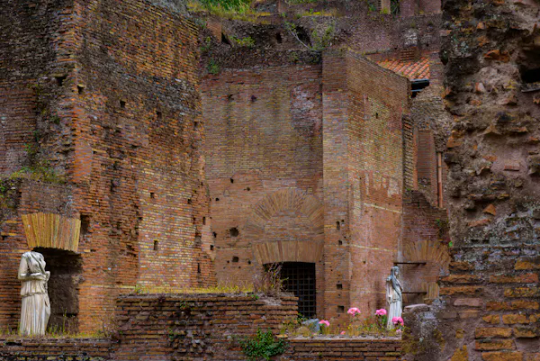
#Vestals#Vestal Virgins#Priestesses of Vesta#Rome's Vestal Virgins: Protectors of The City's Sacred Flame#ancient artifacts#archeology#archeolgst#history#history news#ancient history#ancient culture#ancient civilizations#ancient rome#roman history#roman empire#roman emperors#roman art#ancient art#art history#long post#long reads
33 notes
·
View notes
Text

"No one is folding George Zamias. I am building that mall."
- George D. Zamias, mall developer, speaking about his York Galleria project in 1987.
The Galleria malls, namely the York Galleria and Johnstown Galleria, were the latest and greatest developments planned by George Zamias. Some residents protested Zamias due to fears of traffic, crime, and that York was "over-malled". Zamias fired back at critics, citing his own market research that showed that $46.5 million in sales were being made by York residents out of town. He argued that his "21st century mall" could capture those sales and keep those dollars in York. But the truth is that York was over-malled. The town with a declining population of just over 42,000 residents welcomed the York Galleria as its fifth enclosed shopping mall in 1989 with Boscov's, Sears, JCPenney, and The Bon-Ton; the latter two of these stores were poached from the 20 year-old York Mall next door. Gradually all of the other malls in York closed. But today, Zamias' York Galleria is hurting too - in part because the ruthless Walmart moved into two of the former malls that had been put out of business by the Galleria itself.
Part of my series on the downfall of developers and the now-dead malls they built. Click on the tag "dead mall devs" below to see more.
#dead mall devs#york galleria#photography#dead mall#retail#dead malls#deadmall#mall#malls#shopping mall#shopping malls#retail apocalypse#dead mall series#escalators#pastel#symmetry#exploration#explore#tile#skylight#history#nostalgia#80s aesthetic#aesthetic
58 notes
·
View notes
Text

THIS WEEK AT KOLAJ MAGAZINE
Collective Unconscious, Migrating Forces, & Fragmented Bodies
FROM THE ARTIST DIRECTORY Bubbling from the Collective Unconscious Sylvia Marina Martinez | Monterey Park, California, USA
COLLAGE ON VIEW A Geometry of Hours Jacqueline Dee Parker at Isabella Valise/Devin Borden in Houston, Texas, USA
COLLAGE ON VIEW Fragmented Bodies at Galleria Lorcan O'Neill in Rome, Italy
COLLAGE ON VIEW CoLABELage at Collage-O-Rama at Slip Gallery in Seattle, Washington, USA
FROM THE PRINT ISSUE Alexandra Ackerman's Artist Portfolio in Kolaj #39
FROM THE PRINT ISSUE Migrating Forces in Kolaj #39
INSTITUTE NEWS Street Art Residency Artists Announcement
Read the full update
*****************************
Kolaj Magazine, a full color, print magazine, exists to show how the world of collage is rich, layered, and thick with complexity. By remixing history and culture, collage artists forge new thinking. To understand collage is to reshape one's thinking of art history and redefine the canon of visual culture that informs the present.
SUBSCRIBE | CURRENT ISSUE | GET A COPY
SIGN UP TO GET EMAILS
6 notes
·
View notes
Text

NAME — Shambles FULL NAME — Harmony Jordan FACECLAIM — Samantha Logan GENDER & PRONOUNS — cis woman, she/her AGE — 27 BIRTHDAY — February 15, 1997 OCCUPATION — Waitress at La Galleria/Aspiring Photographer RESIDENCE — {TBD} LENGTH OF TIME IN WILLOW PARK — All her life
BIOGRAPHY | STATISTICS
religious trauma tw
this is harmony, but literally no one calls her that anymore. she goes by shambles, on account of an insanely controversial speech she gave at a charity gala held by her wealthy parents
she was a good little church girl growing up, and really wanted to do the right thing. unfortunately, she had no idea what the right thing was, so she just went along with what her parents said it was
she was pretty indoctrinated into the church and believed it was the right thing to do to get married to the first boy she ever crushed on. they were both 18 and had no idea wtf they were doing
she began sneaking out at night to head to {TBD} and discovered that the people there were not actually demons, like her parents had said. they were good people (most of them), and they were free
there was a slow sanding away at her shiny naive purity and nobody noticed it happening until The Speech.
the chicago tribune called the whole event a shambles, and that became her nickname almost immediately. even if your character wasn't there for it (it was about five years ago now) they'll still call her that. it's how she introduces herself
her parents cut her off financially and in every other way, and her husband got the hell out of there too, not wanting his reputation dragged down with hers
she lives in {TBD} and works at {restaurant} and wants to be a photographer
she still has hints of the sweet naivety she's always had, but it's got a patina of disillusionment on it now
wanted connections:
people who knew her/her family when she was a Good Girl
people who know her ex husband [he'll be a wc of course]
people who saw The Speech
people who know nothing about who she used to be
friends, enemies, lovers, etc!!!
4 notes
·
View notes
Text
Emaar Amaris Sector 62 Gurgaon: The Ultimate Luxury Living Experience
In the heart of Gurgaon, where luxury living meets convenience, Emaar Amaris Sector 62 emerges as one of the most sought-after residential projects.
With its strategic location on the prestigious Golf Course Extension Road and world-class amenities, Emaar Amaris is a perfect blend of modern design, comfort, and elegance.
If you're looking for a home that combines luxury with functionality, Emaar Amaris is the ideal choice.

Whether you're a homebuyer looking for a dream residence or an investor eyeing long-term returns, this project offers everything you need to live life at its best.
Why Choose Emaar Amaris Sector 62?
1. Prime Location with Unmatched Connectivity
Emaar Amaris is located in Sector 62, one of the most coveted localities in Gurgaon.
The project offers excellent connectivity to key commercial, corporate, and retail hubs such as Cyber Hub, MG Road, and Sector 44.
Residents can easily access the Rapid Metro, IGI Airport, and Galleria Market, all of which are just minutes away. Furthermore, Sector 62 is home to renowned schools like Scottish High International School, DPS, and Amity International School, as well as top healthcare facilities such as Medanta and Max Healthcare.
Whether you're commuting for work, education, or leisure, the connectivity around Emaar Amaris is seamless, making it the ideal home for urban professionals and families alike.
2. Luxurious Apartments Designed for Comfort and Style
Emaar Amaris offers ultra-luxurious 3BHK and 4BHK apartments ranging from 2200 sq. ft. to 3100 sq. ft.
These apartments are designed with modern aesthetics and practical living spaces, ensuring ample natural light, excellent ventilation, and privacy.
Each apartment comes with smart home automation, allowing you to control lighting, temperature, and home appliances at the touch of a button or through voice commands.
The integration of cutting-edge technology enhances convenience and creates an exceptional living experience.
3. World-Class Amenities for a Premium Lifestyle
What sets Emaar Amaris apart is its state-of-the-art amenities. This project offers everything you need to live a life of luxury and comfort:
Smart Home Automation: Control lighting, air conditioning, and appliances with voice commands or through a mobile app.
Infinity-Edge Swimming Pool: Enjoy panoramic views of the Aravalli Hills while you relax by the pool.
Fully-Equipped Gymnasium: Stay fit with access to a high-tech gym that meets all your wellness needs.
Grand Clubhouse: A luxurious space to unwind, socialize, and indulge in leisure activities.
Modular Kitchen: Designed for both style and functionality, the modular kitchen is ideal for those who love to cook.
Sports Facilities: The development includes tennis courts, a multi-purpose court, and other recreational spaces to keep you active.
VRV/VRF Air Conditioning: Enjoy the comfort of a climate control system that ensures energy efficiency and year-round comfort.
4. Proximity to Major Corporate Hubs
Emaar Amaris Sector 62 is surrounded by top corporate offices, making it an ideal location for professionals working in the tech and business sectors.
Leading brands like Zomato, Huawei, Dell, and Samsung are located nearby, making your daily commute quick and hassle-free.
Whether you're working from home or commuting to your office, the project’s proximity to corporate hubs is a significant benefit for residents.
5. Surrounded by Other High-End Residential Projects
Emaar Amaris is located in an area surrounded by other luxury developments, further elevating the stature of the project.
Neighboring projects like Mahindra Luminare, 4S Aurrum, and Silverglades Legacy 63A make this location a desirable address for high-end living.
The presence of upscale neighbors adds to the overall exclusivity of the area, making Emaar Amaris an even more attractive investment.
6. Ideal for Investment
Investing in Emaar Amaris offers not just a luxurious lifestyle but also strong potential for capital appreciation. With Gurgaon’s real estate market showing consistent growth, particularly in prime locations like Sector 62, your investment in Emaar Amaris is likely to yield impressive returns.
Whether you're purchasing for personal use or as a rental property, Emaar Amaris provides long-term value, making it a secure and profitable investment.
7. Breathtaking Views of Aravalli Hills
One of the standout features of Emaar Amaris is its stunning views of the Aravalli Hills.
Imagine waking up every morning to lush greenery and picturesque landscapes, creating a serene and peaceful atmosphere.
The panoramic views enhance the appeal of these apartments and make them a perfect retreat after a busy day in the city.
Conclusion: The Epitome of Luxury Living in Gurgaon
Emaar Amaris Sector 62 Gurgaon is the epitome of luxury living, offering spacious apartments, cutting-edge technology, and world-class amenities.
With its prime location, excellent connectivity, and proximity to top corporates, this project offers the best of both worlds: a sophisticated lifestyle and convenience.
Whether you're looking to buy your dream home or invest in a lucrative property, Emaar Amaris is the perfect choice for those seeking an upgraded lifestyle in one of Gurgaon’s most prestigious neighborhoods.
2 notes
·
View notes
Text
The Man with the Twisted Lip
There were probably a couple of opium dens in London, but they were far common in France or the western United States.
London Bridge was the easternmost fixed crossing a vehicle could use in 1889. Tower Bridge was under construction and the Thames Tunnel was used by trains by this point. The latter still is, part of the London Overground. So, it was ferries east of that.
The wharves and docks stretched (mostly) on the north of the river east of London Bridge to Beckton. There were some smaller older quays to the west, like the now Hays Galleria shopping area. The docks at Tilbury also existed and they would take over as ships got bigger, leading to the gradual closure of the old docks, deprivation and then gentrification.
London's Chinatown consisted of less than a thousand residents and was in Limehouse. It is now in Soho, an area that was historically a red-light district but is mostly gentrified now, with a somewhat larger population due to immigration from Hong Kong.
The East End had a reputation as "a wretched hive of scum and villainy" fuelled by stories like this (also the Ripper murders of 1888), but was mainly just very poor. Slum clearance efforts were beginning, but not in any coordinated or effective manner at this point.
Threadneedle Street, in the City of London, is best known as the location of the Bank of England.
Lee was a middle-class suburb that sat on the edge of London in 1889; it had just been taken from Kent and incorporated into the new County of London. But suburban residents in London will still frequently identify with traditional counties.
However, the massive expansion of the city in the first half of the 20th century put Lee in inner London and it today sits in Zone 3 for public transport fares. Indeed, the opening of the railway station in 1866 is what made Lee a desirable area and it still is.
Bow Street police station was a famous police station in London, sharing the building with an equally famous magistrate's court - the building was pretty new, finished in 1881, but the Bow Street Runners before that (set up in 1749 by judge and author of Tom Jones Henry Fielding) were the first effective law enforcement force in London. The former closed in 1992, the latter in 2006 and there is now a museum on site.
"Hugh Boone" would have been charged and fined for breaking the Vagrancy Act of 1824, a piece of Georgian-era legislation enacted because the British government decided that the best way to deal with a surge in poverty and homelessness after the Napoleonic Wars, along with a massive internal influx of economic migrants, was to make rough sleeping and begging illegal, with a maximum sentence of a month's hard labour. This act also covered prostitution, but was in practice mostly used against gay men.
The act remains on the statute books, albeit heavily amended - and somtimes used against homeless people; with 114 people charged in Greater London in 2019-2020. The currently Tory government has pledged to repeal the act and passed legislation in 2022 that will allow for that once a replacement act is enacted to cover some of the other offences in the still-extant text, like hiring children as beggars.
34 notes
·
View notes
Text
David - life-size marble sculpture by Gian Lorenzo Bernini

David is a life-size marble sculpture by Gian Lorenzo Bernini, that was commissioned to decorate the villa of Cardinal Scipione Borghese where it still resides today, as part of the Galleria Borghese. It was completed in the course of 8 months from 1623 to 1624.
#omg#weird ass shit#tumblr fyp#nature#sculpture#art#artwork#oh wow#old#beautiful#david#gian lorenzo#bernini
2 notes
·
View notes
Text

List of Currently Active Belegerande's Staff
Alchemy: Mordred Clarke; House La Fey; A dreadful romantic who has a preference for ornamental flora and Ms. Boone; 46 years old

Defense: Jaime Doola; House Laveau; Secretly a gifted multishifter, but his registered shape is the Gray Fox; Always seems to know more than he's letting on, but is seen as trustworthy by students; 52 years old

Offense: Antebella Boone; House Bell; Heavy-handed but precise in her teaching, also a gifted summoner; 41 years old

Elemental: Titania Greenwood; House La Fey; comes from a long line of Fey-blooded folk and is thusly blessed with immortal life and youth; Cannot lie; Age unknown

Flight & P.E.: Leeper Sinclair; House La Fey; Was once, actually, a former member of the professional broom racing team, Deadbolts, who won the official Broom Racing National Championship in 2014; 37 years old

Divination: Theresa Davenport; House Scrivener; Youngest of Belegerande's faculty but most talented diviner, hoping to be a permanent addition; 30 years old

Illusions: Angela Houdini; House Scrivener; Strict old woman and often heavy-handed in her teaching methods, but loves to 'wow' the students with fanciful illusions; Her relation to The Houdini is coincidental; 81 years old

Summoning: Altair Valentinus; House Scrivener; Another dreadful romantic longing for the Old Days, when spells were uttered as poetry; Comes from a long, long line of powerful vampires once closely related to Pope Valentinus himself; Age unknown

Necromancy: Alexander Night; House Bell; Wealthy prick directly related to Enfurious, and surprisingly strict with his regard to necromancy and respectful practices, one might also call him a skeezy hardass; 43 years old

Blood Magic: Magnus Santafyatè; House Laveau; All around enigma of few words except when teaching, she is equally as strict but more flexible in teaching methods and isn't at all afraid to display the realities of blood magic 39 years old

Transformation & Multishifting: Talula Beauregard; House Scrivener; A Cherokee-French sorceress of notable power, fancying an 'eye' motif to symbolize her divination abilities and loyalty to her House; A vampire; 42 years old

Herbalism: Salem Merauda Anise Morteatum; House La Fey; The resident eccentric of the school's faculty, completely detached from human life including his own; 34 years old

Enchantments: Jewella Gilde; House Bell; She is beautiful and icy, but it is her jewelry that keeps her so; Gilde Family traditions dictate that deceased loved ones' ashes be compressed into diamonds and used in their craft, so much of her enchanted accessories are set with jewels made from her family members; 79 years old; the Gilde family runs Gildebanque's

Hexes & Curses: Vexine Whitlock; House Scrivener; Deceptively older woman, rumored to be over 100, and is famed for her book on The Prevention, Deflection, Mitigation, and Practice of Hexing & Cursing - and ability to back that knowledge up with force

Psychology: Aletta Grimm; House Scrivener; A vampire who looks like a warm hug, she is well versed in human and sorcerer psychology, and her divination abilities strengthen this knowledge and understanding; 167 years old

Arts Classes: Saphira Omay; House La Fey; A calm if mildly anxious were-cat with experience in theater, galleria, a series of fantasy-romance novels, and various dance awards; Rumored to have performed with the Mock-Frogs and songstress Fhara; 49 years old

Beast Taming: Obsidia Barnum; House Laveau; An energetic beast-tamer and shapeshifter whose registered form is the Husky; Her voice is a bit deeper than average and also a bit raspy; 36 years old; great grand-niece to Merauda Barnum

Groundskeeper: Damien Weatherwax; House Laveau; Vivienne's husband and resident quiet bookworm with a great love for sweet tea, tending to the western half of the Belegerande's campus; 55 years old

Groundskeeper: Vivienne Weatherwax; House Bell; Prefers to use a wand when casting and tends to the eastern half of the Belegerande's campus; 43 years old

Councilors: Dr. Vilencia Delirio; House Scrivener; Uses foresight to help figure out the best treatments, having fine-tuned her ability over many years of practice; Vampire; 285 years old

Nurse: Dr. Maryann Heartwell; House Bell; Perpetually exhausted school nurse, doctor, and surgeon who can't get enough coffee in her system; The youngest of all medical staff at Belegerande's; 40 years old

Nurse: Dr. Loomis Shadowmend; House La Fey; His familiar is the snake and he is a very strange, somewhat creepy man; Uses frankenleeches in his practice; Vampire; 89 years old

Dean/Headmaster: Spira Belegerande; House Scrivener; An altogether sinister figure who carefully governs the school; Morally gray and incredibly intimidating; Turned vampire at a young age; Direct descendent of Alistair Belegerande; Exact age unknown, thought to be in the mid 150s

#☿ || Headcanons.#/ just the briefest of summaries for all these people my god#/ also might be adding another prof since.... unu#/ excuse the er screenshot sjhdgfs but there's spira
4 notes
·
View notes
Photo
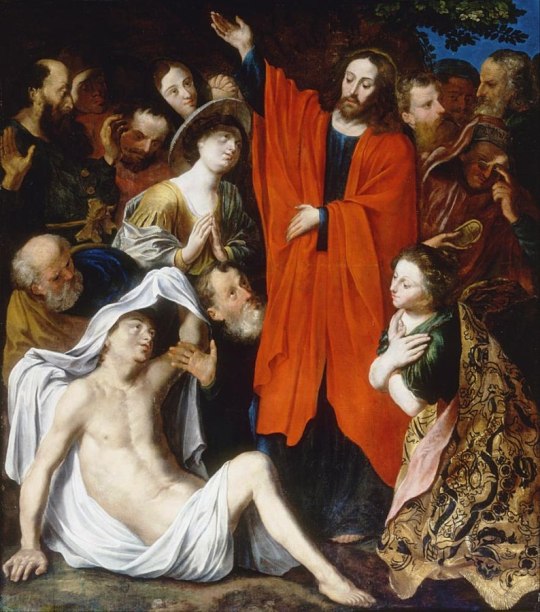
Attributed to Antoon van den Heuvel - The Resurrection of Lazarus -
oil on canvas, 173 × 197 cm (68.1 × 77.5 in)
Sint-Baafskathedraal, Ghent, belgium
Antoon van den Heuvel, Antoine van den Heuvel or Anton van den Heuvel (nickname: 'don Antonio') (c. 1600 – 5 August 1677) was a Flemish history painter and draughtsman. After training and working in Antwerp and Rome, he returned to his native Ghent where he was one of the important creators of altarpieces for the churches in the region.
Antoon van den Heuvel painted mainly religious scenes and portraits. He is usually regarded as a representative of the international Caravaggesque movement. His Lamentation in the Church of Borsbeke relies upon a painting by the Dutch Carravagist Gerard van Honthorst of the same subject for its composition and a number of motifs.
His style is, however, not that easily reduced to the Caravaggesque movement. His early work showed a preference for contrasting colours and strong lighting, with little use of transitional tones. But compared to his contemporary Jan Janssens, one of the foremost representatives of the Ghent Caravaggisti, Antoon van den Heuvel rarely showed Caravaggesque elements. Only in one work, 'Mary with the Christ Child and the Rosary' of 1634 (Church of Nazareth, Belgium, he adopted one of the motifs of Caravaggio: 'The Madonna with the snake' (Rome, Galleria Borghese).
Van den Heuvel's style is in its linear compositions and bright lighting more Classicist in nature and closer to the work of Agostino Carracci, Annibale Carracci and Lodovico Carracci and their followers. He must have seen their work during his residence in Rome.
Van den Heuvel also borrowed motifs and compositions of contemporary Flemish painters such as Rubens and Caspar de Crayer.
His later work between 1640 and 1650 is less colourful and therefore appears less expressive.
Van den Heuvel also made designs for engravings. The paintings (some of them after designs by Rubens) that he (and other painters) made on the occasion of the Joyous Entry of Cardinal-Infante Ferdinand of Austria in Ghent in 1635 were engraved to be included in a publication authored by Willem van der Beke (Guilielmus Becanus). The publication entitled Serenissimi principis Ferdinandi Hispaniarum infantis S.R.E. cardinalis triumphalis introitus in Flandriae metropolim Gandavum was published by Johannes Meursius in Antwerp in 1636. Leading Antwerp engravers Jacob Neefs, Pieter de Jode II and Antony van der Does made the engravings for the publication.
A portrait painting made by van den Heuvel was used by the prominent engraver Paulus Pontius as the basis for his engraving of a portrait of the Flemish poet Jeremias Pierssene.Guillaume Duvivier, an engraver who was active in Ghent in the 17th century, made an engraving after a painting of Antoon van den Heuvel which shows two servant women in a kitchen. This genre subject is atypical for van den Heuvel who mainly painted religious scenes and portraits.
32 notes
·
View notes
Text
THE 10 BEST Places to Go Shopping in Gurgaon District
Welcome to Gurgaon District, a vibrant hub of shopping experiences! Whether you're a local resident or a visitor exploring this dynamic area, Gurgaon offers a plethora of shopping destinations to suit every taste and budget. From upscale malls to bustling markets, there's something here for everyone. Let's dive into the top 10 places you should take advantage of when shopping in Gurgaon District.

Ambiance Mall:
As one of the largest shopping malls in Gurgaon, Ambience Mall boasts a diverse range of stores, restaurants, and entertainment options. From luxury brands to popular retail chains, Ambience Mall offers a premium shopping experience.
DLF CyberHub:
Known for its vibrant atmosphere and eclectic mix of restaurants and bars, DLF CyberHub also features a selection of boutique shops and specialty stores. It's the perfect destination for a day of shopping and dining.
MGF Metropolitan Mall:
Located in the heart of Gurgaon, MGF Metropolitan Mall is a favorite among locals for its extensive selection of fashion brands, electronics, and home goods. It's a one-stop destination for all your shopping needs.
Galleria Market:
Nestled in DLF Phase IV, Galleria Market exudes charm with its open-air layout and boutique shops. From designer clothing to unique handicrafts, Galleria Market offers a delightful shopping experience.
Sahara Mall:
Conveniently situated on Mehrauli-Gurgaon Road, Sahara Mall features a mix of retail outlets, entertainment venues, and food courts. It's a popular destination for both shopping and leisure activities.
Sadar Bazaar:
For those seeking a traditional shopping experience, Sadar Bazaar is the place to be. This bustling market is known for its affordable clothing, accessories, and household items. Bargaining is a must here!
Sector 14 Market:
With its shops and street vendors, Sector 14 Market is a local favorite for budget-friendly shopping. You'll find it all from trendy apparel to fresh produce in this bustling market.
The Gurgaon Central Mall:
Located in Sector 25, The Gurgaon Central Mall offers a curated selection of national and international brands. With its spacious layout and diverse offerings, it's a popular choice for shoppers of all ages. Due to such reasons, people choose to live in Gurugram. To know more, you can see what are the Best Places to Live in Gurugram.
Cross Point Mall:
Situated in DLF Phase IV, Cross Point Mall features a mix of retail stores, eateries, and entertainment options. Its convenient location and relaxed ambiance make it a go-to destination for shoppers.
Galaxy Mall:
Rounding out our list is Galaxy Mall, a vibrant shopping complex in Sector 15. From fashion boutiques to electronics stores, Galaxy Mall offers a diverse shopping experience in the heart of Gurgaon.
Ready to explore the best shopping destinations in Gurgaon District? Plan your shopping spree today and discover the hidden gems waiting to be explored! Don't forget to visit Rajbala, your one-stop shop for Packing and Moving services. Click here to learn more and start shopping with Rajbala today!
2 notes
·
View notes
Text
A Timeline of Duviri
While the Planes of Duviri don't function in a typical linearity, with its cyclical story spirals happening day after day, there is something of a timeline of events in the pocket universe, largely revolving around the lost islands of Duviri. This is an attempt at creating that timeline. This will contain spoilers for both the Duviri Paradox quest, as well as the Lost Islands of Duviri Fragments. Most of this is conjecture - the timeline of Duviri is pretty nebulous, and so I've had to guess based on context as to when events occurred.
The first event in the Duviri timeline is the establishment of the kingdom, during the Zariman 10-0 Incident. A young Drifter creates Duviri based on their storybook, Tales of Duviri, with the appearance of Dominus Thrax based on a doll the child owned.
The earliest event in Duviri history that we know of appears to be the arrival of The Scholar, an unnamed stranger who was granted the island of Scholar's Landing. Eventually, this island, and its inhabitant, would disappear.
Following this, I believe the first natural loss of an island occurred, which I'm guessing would be the Execution Cyst.
Then, the Bleeding Earth occurs, where a farmer named Hovrel discovers a spring of oily blood while digging on the island of Cornucopia. One person tasted it, and was immediately corrupted by the fluid. Thrax isolated and then severed the island of Cornucopia from the mainland.
Following this, an undercroft portal forms at the bottom of Lake Verula, resulting in the spread of Golden Maws across the Islands, and the draining and destruction of the lake.
Several more islands disappear over this time, including the Golden Hive and the Inversion Tree, while Thrax orders that the Shrines of the island of Lorn be disassembled and moved to the mainland.
Thrax eventually orders Manipura Island destroyed, along with its residents, the Calaventi sisters and their tennant farmers, after he is informed of their seditious comments by the family's staff.
Acritis witnesses an enormous finger emerge from the ground of the Galleria, and informs Thrax, who orders the island destroyed in fear.
Stitcher's Gulch and the Bountiful Swamp both vanish.
The Island of Lorn is severed from Duviri by disgruntled citizens, who break the bridges which connected it to the rest of Duviri, and dragged it away by tying Kaithes to the island with ropes.
The Rain of Chains occurs, where broken pieces of chain start falling from a red "veil" in the sky, injuring many citizens of Duviri, and killing Garmi, Mathila's husband, and destroying the Seriglass lighthouse atop Watcher's Island. Before his death, Garmi records an audio log detailing his vision of an enormous hand missing one of its fingers emerging from the Void. Three spirals later, the island itself vanishes.
Following the Rain of Chains, the Hollow Children begin appearing, until Thrax orders the island of Academe destroyed, only to find it has drifted away by itself. Around this time, I believe the Doll Mausoleum and Necropolis Island also vanish.
Teshin arrives on the island of Hermit's Landing, and is nursed back to health by Mathila. I presume he establishes his cave on this island, otherwise the island is lost. At some point, the Drifter meets Teshin, and names the Rablit who lives with the former Dax.
Finally, the Meteor of Natah's Hand falls on Duviri during the Drifter's execution, resulting in them escaping, and beginning the events of the Duviri Paradox.
While some of the characters in Duviri mention past events, like the crowning of Dominus Thrax, or the previous rulers of Duviri whom Lodun would have inherited the throne from, I believe these events did not occur within this version of Duviri, rather being holdovers from when Duviri was a storybook, where they were included as part of the setting description. Given this iteration of Duviri was created by the Drifter, I find it most likely that Thrax was on the throne from the start of its existence, as it was created with that in mind, as that is how the stories in Tales of Duviri seem to be written.
8 notes
·
View notes
Text
Event Translation — Brand New Journey ~Italy Expedition Volume~
Episode 8: Galleria Umberto I
—After their one full day of sightseeing was over, (Player Name) and the others returned to Naples.
A recently built arcade stands right in the middle of a street lined with shops both new and old.
Marks: There are so many people out, even though it’s nighttime.
Carcanore: Hey, look, it’s Galleria Umberto I.
Marks: ...? What’s that?
Benetta: This shopping gallery. It was built in the 19th century, during the large-scale redevelopment of Naples that followed the cholera epidemic.
Benetta: After that, problems such as deterioration did come up, but it’s still the foremost shopping gallery in Naples, and always bustling with people.
Carcanore: The domed ceiling is fifty-eight meters tall, and isn’t the mosaic on the floor gorgeous? It depicts the twelve constellations.
Carcanore: You can find everything from fast-food restaurants to menswear stores with a century of established history here. There are other such galleries and shopping districts around, but I think this one is the most “Naples-like” of them all.
Benetta: Precisely. —ah, that reminds me.
Benetta: I have some business at the shoe store. Did you receive the items you ordered?
The boutique Benetta went to was one of an ultra-luxury brand.
Cutlery: H-Hold on a second! Is this... Salvatore Gamoferra*!?
Carcanore: Yep, Benetta only wears Gamoferra shoes.
Cutlery: I thought you were wearing super well-tailored clothes...! How much do your wardrobes even cost...!
Benetta: Sorry to keep you waiting.
Marks: Is this store really that impressive?
Cutlery: It’s a first-rate brand! It’s beyond expensive.
Benetta: We hold Bella Figure in high esteem, and that means maintaining a pristine appearance.
Benetta: Wearing products made by a trusted brand that represents Italy is only natural.
Benetta: All of your clothes are from this brand as well, aren’t they?
Cutlery: Eh! Seriously!? You gave clothes like that to tourists who were just passing by...
Benetta: I couldn’t bring shame to my guests, could I? Especially when they saved Bonito’s life.
Carcanore: Anyway, wanna take a little break and hit up a bar? There are some places here that are famous for their cannoli.
Benetta: Before that... Bonito.
Bonito: Yeah?
Benetta: Go put these shoes in the car, please. It’s not becoming to walk around with a large number of shopping bags.
Bonito: ...a-ah! No problem at all.
Carcanore: ......
The bar was crowded with a large number of people. Tourists and residents of Naples all mingle together.
Master:
Today’s been fun.
We were able to enjoy Italy to the fullest thanks to you.
Carcanore: We should be thanking you too! You gotta come again sometime. I can show you around way better next time.
Cutlery: Yeah. ...I thought bars like this only served alcohol, but there’s all kinds of food here too, huh?
Carcanore: Yep, everyone here in Naples has their favorite bar.
Marks: The pubs in England feel totally different. This place is lively, but still relaxed...
Benetta: That’s also Bella Figura.
Marks: Really?
Benetta: Indeed. Well-becoming behavior is also essential.
Benetta: That’s why, even when going to bars, it’s unheard of to dress poorly or disgrace yourself with intoxication.
Benetta: My gun, as you can see, also honors beauty.
Benetta placed his gun on the table. The upper third of the slide is missing, and the barrel is exposed.
Marks: ...the barrel looks off. What does that mean for how it functions?
Benetta: It means that it’s beautiful.
Marks: ...beautiful... Master, do you understand? I don’t get it at all.
Benetta: It’s fine if you don’t understand. ...is Bonito not back yet?
Carcanore: Should I pay now? Umm... I wonder if I have one for this place.
Carcarnore pulled a pouch out of his bag— stuffed full to bulging with its contents.
Cutlery: What’s that?
Carcanore: Hold on a sec... got it!
The pouch had all kinds of discount coupons inside, and Carcarnore took one of them out.
Carcanore: I got this coupon half a year ago! The expiration date is... wow, just in the nick of time! It’s today, how lucky~♪
Cutlery: ...is this Bella Figure too?
Benetta: No...
Benetta: Carcanore is a fine person, and fundamentally Bello. However, I don’t think this frugal behavior is ideal...
Carcanore: I can’t help it. Even I don’t know why I do it— it’s just my nature, at this point. Or maybe a habit?
Carcanore: Also, can you cut it out with the “frugal behavior” jab? I just understand the value of money! Isn’t it smart to think like that?
Benetta: I’m not going to answer that.
Bonito: Sorry for the wait! The shoes are in the car now.
Bonito finally returns. Instead of sitting down, though, he took a step back. For an instant, (Player Name) feels a chill run down their spine.
Marks: —nh!
*gunshot*
Benetta shot Bonito.
Cutlery: ...huh?
Notes:
*“Salvatore Gamoferra” is an altered version of “Salvatore Ferragamo”, a real (and also highly expensive) Italian brand.
15 notes
·
View notes
Text
Some games on the PSN Black Friday sale. Full list here, ends November 27th.
AI: The Somnium Files
Alternate Jake Hunter: Daedalus The Awakening of Golden Jazz
A Way Out
Azure Striker Gunvolt 3
Azure Striker Gunvolt: Striker Pack
Back 4 Blood
Batman: Arkham Knight
Batman: Return to Arkham
Blaster Master Zero
Blaster Master Zero 2
Blaster Master Zero 3
Blazblue Cross Tag Battle
Bloodborne
Bloodstained: Curse of the Moon
Bloodstained: Curse of the Moon 2
Bloodstained: Ritual of the Night
Chaos Code
Crash Bandicoot 4
Crash + Spyro Triple Play Bundle
Crisis Core: Final Fantasy VII Reuinion
Cuphead
Danganronpa 1-2 Reload
Danganronpa V3
Dark Souls Remastered
Dark Souls 3
Devil May Cry HD Collection + 4 Special Edition Bundle
Disgaea 6 Complete
Disgaea 7
Dragon Ball FighterZ
Dragon Ball Z: Kakarot
Dragon Marked for Death
Dragon's Dogma: Dark Arisen
Earth Defense Force 4.1
Earth Defense Force 5
Earth Defense Force: Iron Rain
Earth Defense Force: World Brothers
Eiyuden Chronicle: Rising
Fairy Fencer F: Advent Dark Force
Fallout 4
Final Fantasy VII Remake
Fire Pro Wrestlng World
Forspoken
Ghostrunner
Ghostwire: Tokyo
Gleamlight
God of War(PS4)
God of War: Ragnarok
GrimGrimoire OnceMore
Gunvolt Chronicles: Luminous Avenger iX
Gunvolt Chronicles: Luminous Avenger iX 2
Hades
Horizon: Zero Dawn
Horizon Forbidden West
Immortals Fenyx Rising
Jak and Daxter Bundle
KATANA KAMI: A Way of the Samurai Story
Kowloon Highschool Chronicles
Labyrinth of Galleria: The Moon Society
Lies of P
Made in Abyss: Binary Star Falling into Darkness
Mafia: Definitive Edition
Marvel's Guardians of the Galaxy
Marvel's Midnight Suns
Marvel's Spider-Man
Marvel's Spider-Man: Miles Morales
Megadimension Neptunia VII
Mega Man Zero/ZX Legacy Collection
Melty Blood: Type Lumina
Metal Slug 3
Metal Slug Anthology
Metal Slug XX
Mobile Suit Gundam Battle Operation Code Fairy Vol. 1
Naruto to Boruto: Shinobi Striker
Nier Rplicant
Nier Autimata
Nitroplus Blasterz
One Piece: Pirate Warriors 4
One Punch Man: A Hero Nobody Knows
Persona 3: Dancing in Moonlight
Persona 5 Strikers
Persona 5: Dancingin Starlight
Puyo Puyo Tetris
Rayman Legends
Resident Evil 4 remake
Resident Evil 7
Rhapsody: Marl Kingdom Chronicles
River City Girls 2
River City Melee Mach
River City Saga: Three Kingdoms
RWBY: Arrowfell
Sifu
Sol Cresta
Sonic Origins
Spyro: Reignited Trilogy
Star Wars Jedi: Fallen Order
Star Wars Jedi: Survivor
Steins; Gate Elite
STEINS;GATE: My Darling's Embrace
Stubbs the Zombie in Rebel Without a Pulse
Super Bomberman 2
SUPERHOT
Super Neptunia RPG
Teenage Mutant Ninja Turtles: Shredder's Revenge
Teenage Mutant Ninja Turtles: The Cowabunga Collection
The Evil Within
The Evil Within 2
The Last Campfire
The Legend Nayuta: Boundless Trails
The Outer Worlds
The Quarry
The Wonderful 101: Remastered
Tony Hawk's Pro Skater 1 + 2
Valkyria Chronicles 4 Complete Edition
Voice of Cards 1-3
Warhammer 40,000: Boltgun
Warm Snow
Wild Hearts
World End Syndrome
Yakuza: Kiwami
Yakuza: Kiwami 2
Zanki Zero
#Disgaea#Yakuza Series#Zanki Zero#World End Syndrome#The Evil Within#Resident Evil#The Legend of Nayuta#Star Wars#Sonic the Hedgehog#RWBY#Valkyria Chronicles#A Way Out#Blaster Master#Voice of Cards#Neptunia#River City Ransom#Gunvolt#Spider-Man#Nier#God of War#Rhapsody: Marl Kingdom Chronicles#Earth Defense Force#Danganronpa#Batman#TMNT#Persona Series#AI: The Somnium Files#Final Fantasy#Melty Blood#Metal Slug
4 notes
·
View notes